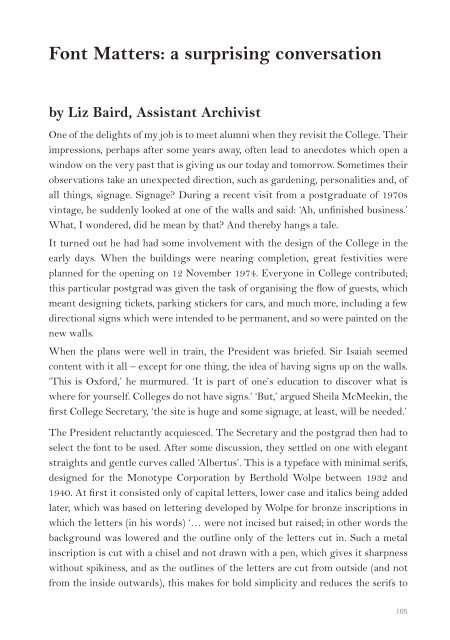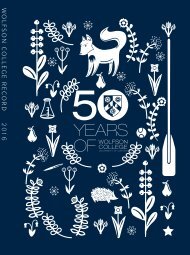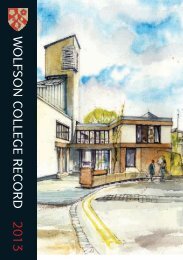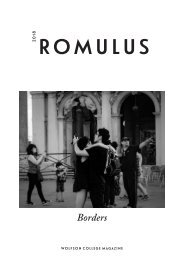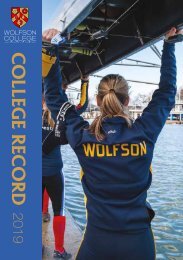You also want an ePaper? Increase the reach of your titles
YUMPU automatically turns print PDFs into web optimized ePapers that Google loves.
Font Matters: a surprising conversation<br />
by Liz Baird, Assistant Archivist<br />
One of the delights of my job is to meet alumni when they revisit the <strong>College</strong>. Their<br />
impressions, perhaps after some years away, often lead to anecdotes which open a<br />
window on the very past that is giving us our today and tomorrow. Sometimes their<br />
observations take an unexpected direction, such as gardening, personalities and, of<br />
all things, signage. Signage? During a recent visit from a postgraduate of 1970s<br />
vintage, he suddenly looked at one of the walls and said: ‘Ah, unfinished business.’<br />
What, I wondered, did he mean by that? And thereby hangs a tale.<br />
It turned out he had had some involvement with the design of the <strong>College</strong> in the<br />
early days. When the buildings were nearing completion, great festivities were<br />
planned for the opening on 12 November 1974. Everyone in <strong>College</strong> contributed;<br />
this particular postgrad was given the task of organising the flow of guests, which<br />
meant designing tickets, parking stickers for cars, and much more, including a few<br />
directional signs which were intended to be permanent, and so were painted on the<br />
new walls.<br />
When the plans were well in train, the President was briefed. Sir Isaiah seemed<br />
content with it all – except for one thing, the idea of having signs up on the walls.<br />
‘This is Oxford,’ he murmured. ‘It is part of one’s education to discover what is<br />
where for yourself. <strong>College</strong>s do not have signs.’ ‘But,’ argued Sheila McMeekin, the<br />
first <strong>College</strong> Secretary, ‘the site is huge and some signage, at least, will be needed.’<br />
The President reluctantly acquiesced. The Secretary and the postgrad then had to<br />
select the font to be used. After some discussion, they settled on one with elegant<br />
straights and gentle curves called ‘Albertus’. This is a typeface with minimal serifs,<br />
designed for the Monotype Corporation by Berthold Wolpe between 1932 and<br />
1940. At first it consisted only of capital letters, lower case and italics being added<br />
later, which was based on lettering developed by Wolpe for bronze inscriptions in<br />
which the letters (in his words) ‘… were not incised but raised; in other words the<br />
background was lowered and the outline only of the letters cut in. Such a metal<br />
inscription is cut with a chisel and not drawn with a pen, which gives it sharpness<br />
without spikiness, and as the outlines of the letters are cut from outside (and not<br />
from the inside outwards), this makes for bold simplicity and reduces the serifs to<br />
105


